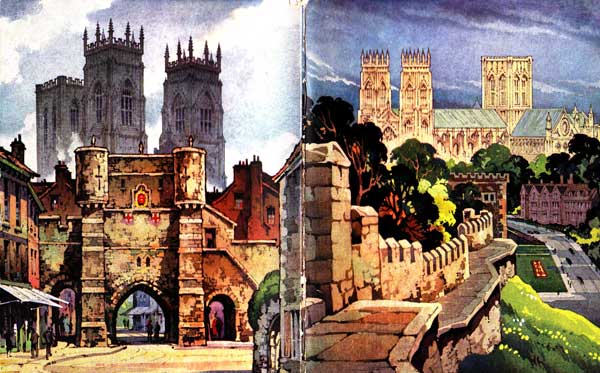
 Our 700-year-old Minster stands where the Romans first built a fortress 12 centuries earlier. Meanwhile many city centre streets follow the same pattern laid out by the Vikings a thousand years ago.
Our 700-year-old Minster stands where the Romans first built a fortress 12 centuries earlier. Meanwhile many city centre streets follow the same pattern laid out by the Vikings a thousand years ago.
Sometimes it seems nothing much ever changes in York.
But the official guide to the city published in 1961 demonstrates that York has changed radically in the last 50 years. The 112-page guide was originally priced two shillings and sixpence, but cost £2.20 when I picked it up in a second hand bookshop last week.
The guidebook looks ahead to the opening of the university – the Heslington campus welcomed its first 216 students 50 years ago in October.
And it goes on to note that the city had four grammar schools.
Here are six more things in the 1961 guide that have disappeared from York.
1. Early closing

Hard to imagine in an era when people start panic buying on a bank holiday just because Tesco is to close at 4pm, but in 1961 York shut every Wednesday afternoon.
The city had more family-run shops in the Sixties. Those advertising at the back of the guide include John Saville & Sons Ltd on Goodramgate “for everything photographic” which sold “all the latest cine cameras”.
On Spurriergate, W Grant & Son, watchmakers and jewellers, made bracelet charms depicting York Minster, Clifford’s Tower and the “torch extinguisher”.
2. The late post

The latest cut to befall Royal Mail in York came when the city lost its postmark and the last post at Leeman Road was changed from 6.30pm to 6pm.
Fifty-two years ago you could drop off a London-bound letter at the sorting office at 8.30pm or one for Newcastle as late as midnight and see it delivered the following morning.
3. The word ‘omnibus’

In a week when “omnishambles” made it into the online Oxford Dictionary, here’s a defunct use for the prefix.
Sadly nobody puts “omni” in front of “bus” any more. In the 1961 guide you couldn’t move for “omnibus starting points”, “omnibus parks” and “omnibus tours”.
4. These restaurants

Eating out was a very different experience in 1961. While cafés, coffee houses and restaurants abound in modern York, the old guide lists only 32, with a mere 11 these licensed to serve alcohol.
Some names survive: Betty’s of course, the Dean Court Hotel and the Shoulder of Mutton in Heworth. But other names are lost to us, including the only two places listed which serve food from other countries. Both the Hong Kong Restaurant on Stonegate and the Kow Loon on Micklegate specialised in “English and Chinese meals”.
Here are some other long-gone places to eat and drink: the Creamery Restaurant on Pavement; Goodfare restaurants on both Pavement and Jubbergate; the Horseshoe Café on Bridge Street; Peter Madden’s, High Petergate; The Grill, Blossom Street; the Tiger Hotel, Market Street; and the Tudor House Café on Stonegate.
5. The cattle market

Cattle and sheep being herded through parts of the city was once a regular sight in York: the 1961 guide lists cattle market days as Monday and Thursday. The market was moved to Murton ten years later.
6. Once great industries

Even the most clear-eyed futurist must feel a twinge of nostalgia for the “proper” industries that have gone from York.
The guide talks with pride of a carriage and wagon works which “cover an area of 62 acres, of which 19 acres are roofed buildings”.
Added in 1945, the coach construction block is “generally acknowledged to be the finest in the country”. And among the 3,000 employed in the works are “craftsmen acknowledged to be amongst the finest in the country on coach-body building”.
Also covered are Rowntree’s (“with a labour force of over 10,000 workers”), Terry’s and instrument maker Cooke, Troughton & Simms – the distant legacy of which is Nanometrics UK at York Business Park.
Back in ’61 the Haxby Road firm was a world leader in its field. “The new Primary Triangulation of Great Britain was carried out with Cooke theodolites,” the guide notes.
Whose theodolites are triangulating Britain today?
- Read more articles about York’s history here
